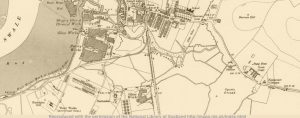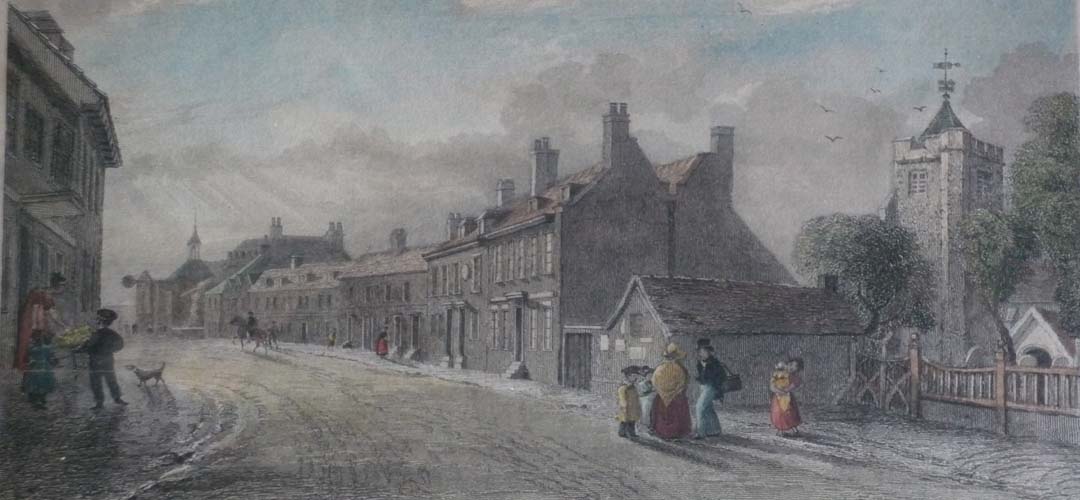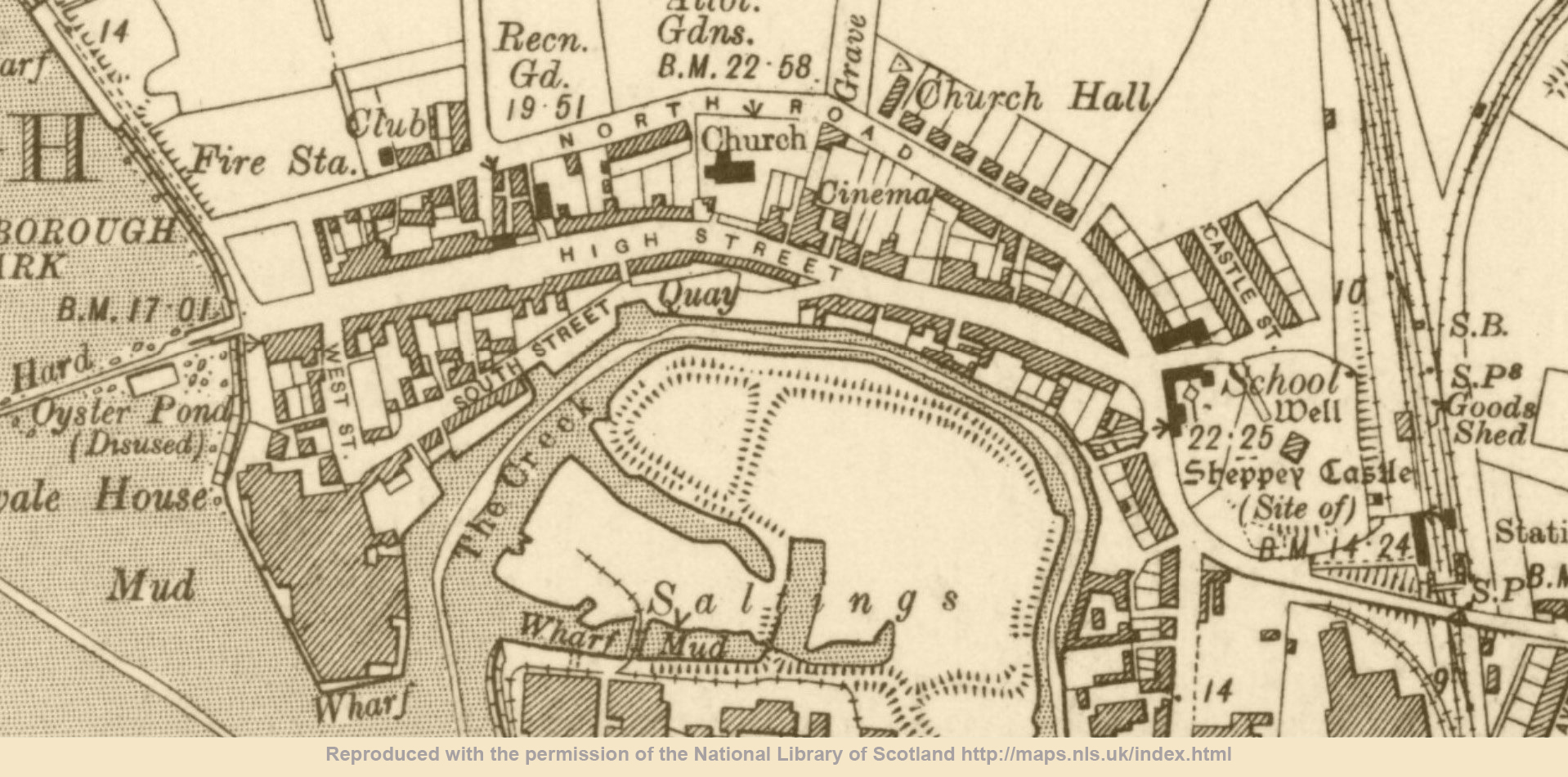HISTORIC QUEENBOROUGH 1934
Brief History of the Town
Under the auspices of Edward III, Queenborough rose from the Swale and Medway marshes, and became a ‘new town’ of the Middle Ages. Having realised the vulnerability of this part of his realm to continental invasion, Edward built here a castle in 1361. At the same time he transformed what was, until then, a small fishing hamlet called Bynnee, into a flourishing medieval port.
This whole fortified development he renamed Queenborough, in honour of his consort, Queen Philippa of Hainault. He further bestowed upon it the title of a Royal Borough, following the granting of its Charter in 1368.
That same year, by Royal decree, the Wool Staple was transferred from Canterbury to Queenborough which, together with Sandwich, became one of the only two places in Kent through which all the exported wool was compulsorily directed.
Thus established, Queenborough prospered, until with increased competition from more readily accessible ports, such as Rochester, Chatham and the developing naval port of Sheerness, the role for which the town was originally intended began to decline.
This situation was accelerated when, in 1650, the Commonwealth Government decreed that the castle, which had stood majestically surveying the Swale and Medway estuaries for three hundred years, was of no further practical use and was subsequently demolished.
In 1667 the Dutch destroyed much of the British Fleet in the Thames estuary and captured Sheerness and Queenborough. This invasion lasted only a few days, the Dutch not having a liking for the place. More recently, in 1967, a proper and more dignified handover was amicably arranged; the Queenborough Brielle Twinning arrangement was created and Sheppey residents are now regularly and cheerfully invaded by their Dutch friends and visitors and in return are also welcomed in Holland.
Following the Dutch invasion, much attention was given to the improvement of the naval defences of the Medway. This brought with it a train of prosperity for Queenborough. The Church was refurbished between 1690-1730, and fine houses built during the rest of the 18th century. The town had the advantage of the patronage of two members of Parliament, and this, with the general prosperity of the mercantile and colonial trade of the period, kept Queenborough in some sound comfort.
The naval connection lasted well up to the age of Nelson who, with other notable naval dignitaries, frequently enjoyed the homely delights of the town and its then numerous Inns.
Early in the 19th century things began to deteriorate. The oyster fishing, plagued by corruption and smuggling, waned, and the patronage – or, as some would see it, bribery – of the members of Parliament was destroyed by the Reform Bill of 1832. Queenborough in the 1850’s was a very sorry place indeed; broken down and almost lawless.
The once bold British Navy, which used to moor in the Medway, had been largely replaced by the notorious prison ships which frequently buried their dead on the local salt-marsh called Deadman’s Island, at the mouth of the Swale. Sheerness had taken over in a big way as a port, dockyard and garrison town at the mouth of the Medway. Thus the one time medieval role of Queenborough had been adopted by the energetic and enterprising Victorians of Sheerness, down the river.
From the all-time low of the 1850s there began a process of bustling recovery. New industries came to Queenborough – the Glass Works, coal washing, cement works, potteries. Other small enterprises grew well, like Sheppey Fertilizer company and the Glue Works. The River Swale was bridged when the railway came in 1860. A new Dutch ferry then started from Queenborough. (The disused railway terminal pier, which was subsequently used by the Royal Navy as a minesweeper base, during the 1939/45 prior to its demolition in the 1950’s). The new Borough Charter of 1885 gave the necessary impetus to a flagging Borough Council. The Church had good clergy and received necessary repair, and reform began to change things for the better all round.
In walking around Queenborough you will see a great deal of the impact of the late Victorian and Edwardian industrial expansion, which restored the fortunes of the town.
Our present post-war years, too, are noted by the decline of the former railway facilities and chapels. However this needs to be matched against developments such as the modern pharmaceutical factory of Abbotts Laboratories (now Aesica), new sea-wall defences, a large yachting harbour, restoration of older houses and, further afield, the massive car parks for imported cars and their attendant industries.
Today the town continues its nautical associations, for the creek is still constantly in use by local residents, fishermen and industry. In the summer months its estuary is alive with yachting enthusiasts.
Queenborough today represents an authentic 18th century seafaring town, from which period most of its more prominent buildings survive. The church is the sole survivor from the medieval period, much is the pity, but many of those buildings remaining are all of a period, and so capture an atmosphere that has remained very little changed for over two hundred years.
The only way to see any town properly is to walk through its streets, look at its buildings and breathe its air. To the casual visitor Queenborough might appear to offer very little, since it has no outstanding buildings, but its quality lies elsewhere, as it has hoped this ‘walk around‘ will reveal.
In this brief tour we shall have to confine ourselves in the main to the Conservation Area, but there is much to see in the adjoining streets and countryside. At the moment only a few interiors of buildings can be viewed, but visitors will still find much to please them.


